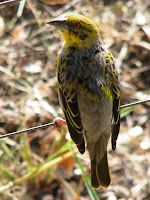Those who regularly visit my blog know that birds are my favourite "targets". Every time I have the opportunity to view a Burchell's coucal so "close at hand", I get every excited, because generally this bird is known to be shy = prefers to hide instead of "posing".

In the Kruger National Park, birds like this Spotted-backed weaver were also in abundance during our last tour.
This bird bath at the day-centre at the Lower Sabie camp is one of my favourite sites in the Kruger Park to observe (& of course, to photograph) birds "at play".
Birds "of all feathers" gather at this bird path to drink & of course, to have a refreshing "splash".
However often I visit the African penguin colony at Boulders Beach (on the False Bay-side of the Cape Peninsula), I don't get tired of photographing these flightless birds, which look so cute when they "waddle" along.
Just as these penguins (formerly known as Jackass penguins, because of their donkey-like braying) breed throughout the year, the moulting process takes place throughout the year, lasting for about a month.
An immature penguin is dependent on either of its parents for food - seen "begging" for it in the photo - which adults regurgitate for the benefit of their youngsters.
After feeding its hungry youngster, the adult penguin is seen relaxing - although the youngster appears to want more!?
Friday, August 27, 2010
Birds in Abundance
Tuesday, August 17, 2010
Uninterrupted Wilderness

The next moment one of the monkeys jumped "through the air", landed on a nearby rock . . . .
. . . . and took off again, now "flying" through the air.
"Down the road" we encountered a herd of elephants, always endearing in the way they intimately care for each other . . . .
. . . . especially revealing concern for the wellbeing of youngsters amongst them.
Members of the cat family often are illusive, especially during the "heat of the day", so "discovering" these lions created great excitement.
When smeared with blood, this lioness appeared, we realised that behind the bushes, the lions had just finished feasting on a kill.
On to the Hluhluwe Game Reserve (KwaZulu-Natal), where the game viewing was rather disappointing, until . . . . we spotted this wild dog. What a sighting - creating great excitement - even for frequent visitors to the wild.
As was the case with the lioness, the wild dog in the road ahead was "coated" with blood. It also was panting heavily - as if it had just "overtaxed" itself!?
Saturday, August 14, 2010
Winter Landscape

From Joburg and the highveld we travelled to the lowveld & toured along the Panorama Route - where the Blyde River Canyon was also "decked" in winter colours.
Once we reached the Kruger National Park, nature "revealed" that all was not bleak - along the river systems the colour green is eminent throughout the year. Although cold at night, the days are warm & similar to humans, these hippos enjoy basking in the sun.


Although the Soccer World Cup in South Africa is by now "come & gone", reminders of it can still be found all over our country - like this "Welcoming Sign" in Graskop (Mpumalanga Province) . . . .
. . . . or this multitude of flags at the Waterfront in Knysna . . . .
. . . . or this extra-ordinarily large vuvuzela in Cape Town on the what I call "the road to nowhere" (= a part of a highway never completed).




















